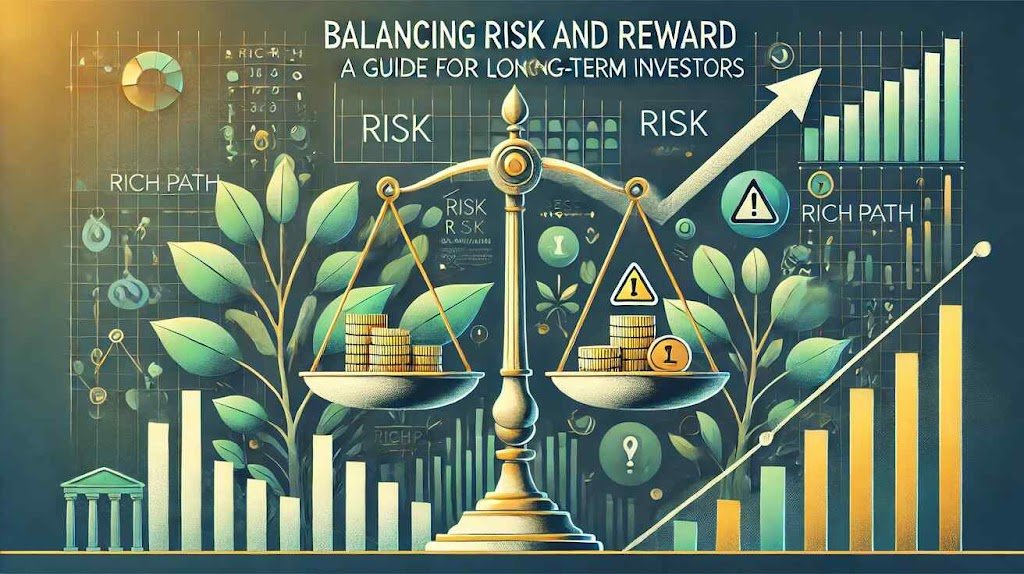Balancing Risk and Reward: 1 Powerful Guide for Long-Term Investors

Balancing risk and reward
This comprehensive guide delves into the principles of balancing risk and reward, offering practical insights and strategies tailored for Indian long-term investors.
What Does Balancing Risk And Reward Mean in Investing?
Risk in investing refers to the possibility of losing some or all of your invested capital. It can stem from various factors, such as market volatility, economic downturns, or company-specific issues. On the other hand, reward is the potential return or profit you earn on your investments over time.
For instance, investing in stocks carries a higher risk compared to fixed deposits, but it also offers the potential for significantly higher returns. The goal for long-term investors is not to eliminate risk entirely (which is impossible) but to manage risk effectively while maximizing rewards.
Why Is Balancing Risk and Reward Important?
Balancing risk and reward is crucial because it ensures that your investments align with your financial goals, time horizon, and risk tolerance. Mismanaging this balance can lead to either:
- Excessive Risk: This might result in significant losses during market downturns.
- Excessive Caution: This might lead to missed opportunities for higher returns, especially over the long term.
Real-Life Example of Balancing Risk And Reward
Take the case of Anita, a 30-year-old software engineer from Bengaluru. Anita decided to invest 100% of her savings in stocks, hoping for high returns. However, during a market correction, her portfolio lost 30% of its value, causing panic. A balanced approach—perhaps allocating 70% to stocks and 30% to debt instruments—would have mitigated her losses while still offering growth potential.
Understanding Risk Tolerance
What Is Risk Tolerance?
Risk tolerance is your ability and willingness to endure losses in pursuit of potential gains. It is influenced by factors such as:
- Age
- Financial situation
- Investment knowledge
- Emotional capacity to handle market volatility
Types of Investors Based on Risk Tolerance
- Conservative Investors: Prefer low-risk investments like fixed deposits, government bonds, and large-cap mutual funds.
- Example: Ramesh, a 55-year-old teacher in Delhi, focuses on preserving his savings for retirement.
- Moderate Investors: Willing to take calculated risks by investing in a mix of equities, debt, and gold.
- Example: Priya, a 40-year-old businesswoman in Mumbai, balances growth and stability in her portfolio.
- Aggressive Investors: Seek high returns by investing in high-risk assets like small-cap stocks or cryptocurrencies.
- Example: Karthik, a 28-year-old entrepreneur in Hyderabad, invests heavily in equities for long-term growth.
Key Strategies to Balancing Risk and Reward
1. Diversification
Diversification is the practice of spreading investments across different asset classes, industries, and geographies. It reduces the impact of poor performance in any one investment.
Example: If Nikhil invests ₹10 lakhs in just one stock and it performs poorly, he risks losing a significant portion of his capital. By diversifying across 10-15 stocks, mutual funds, or ETFs, he minimizes this risk.
2. Asset Allocation
Asset allocation is the process of dividing your portfolio among asset classes like equities, bonds, gold, and real estate based on your financial goals and risk tolerance.
- Young Investors (20s-30s): Higher allocation to equities for growth.
- Example: Seema, a 25-year-old in Pune, invests 80% in equity mutual funds and 20% in debt instruments.
- Mid-Life Investors (40s-50s): Balanced allocation for growth and stability.
- Example: Ajay, a 45-year-old banker in Chennai, allocates 50% to equities, 30% to debt, and 20% to gold.
- Near-Retirement Investors (60+): Focus on preserving capital with lower equity exposure.
- Example: Vandana, a 60-year-old retiree in Jaipur, keeps 70% in bonds and fixed deposits and 30% in dividend-paying stocks.
3. Rebalancing
Rebalancing involves reviewing and adjusting your portfolio periodically to maintain the desired asset allocation. This ensures you don’t take on more risk than intended.
Example: If equities outperform and grow from 60% to 80% of your portfolio, rebalance by shifting some gains into bonds or gold.
4. Systematic Investment Plan (SIP)
SIPs allow you to invest small amounts regularly in mutual funds, reducing the impact of market volatility through rupee cost averaging.
Example: Rekha, a salaried employee in Kolkata, invests ₹5,000 monthly in a diversified equity mutual fund. Over 15 years, she benefits from consistent returns without worrying about market timing.
5. Risk Assessment Tools
Leverage financial tools and calculators to assess the risk levels of your investments. Many Indian platforms, like Zerodha, Groww, and ICICI Direct, offer these resources.
Balancing Risk and Reward in Different Asset Classes
1. Equities
- High Risk, High Reward
- Suitable for long-term goals like retirement or children’s education.
- Mitigate risk by investing in large-cap stocks, index funds, or blue-chip mutual funds.
Example: Mahesh, a 35-year-old from Nagpur, invests in the Nifty 50 index fund to capture broad market growth with relatively lower risk.
2. Debt Instruments for balancing risk and reward
- Low Risk, Steady Reward
- Suitable for short- to medium-term goals.
- Options include fixed deposits, government bonds, and debt mutual funds.
3. Gold
- Moderate Risk, Hedge Against Inflation
- Allocate 5-10% of your portfolio to gold.
- Consider Sovereign Gold Bonds (SGBs) for tax-efficient gold investments.
4. Real Estate
- Moderate to High Risk, Potential for Capital Appreciation
- Invest for diversification but be aware of liquidity risks.
5. Emerging Assets (Cryptocurrency, REITs)
- High Risk, Speculative Reward
- Allocate sparingly if you have high-risk tolerance.
Managing Emotions in Investing
Long-term investing requires patience and discipline. Avoid making impulsive decisions based on market fluctuations.
Example: During the 2020 market crash, many panicked investors sold their stocks at a loss. Savvy investors like Ritu, who stayed invested, saw their portfolios recover and grow as markets rebounded in 2021.
Final Thoughts: Creating Your Balanced Portfolio with balancing risk and reward
Balancing risk and reward is a dynamic process. As you progress in life, your financial goals and risk tolerance will change, requiring adjustments to your portfolio. The key is to stay informed, disciplined, and consistent.
By following the strategies outlined above, you can build a resilient portfolio that not only navigates market uncertainties but also grows steadily over the long term. Remember, investing is a marathon, not a sprint. With a balanced approach, you can achieve your financial dreams and secure a prosperous future.
For more insights into mutual fund investment strategies, visit Rich Path. If you found this article helpful, share it with your friends and family. Have any questions or topics you’d like us to cover? Leave a comment below—we’d love to hear from you!
Read More-
Best Mutual Funds for Beginners in India: A Comprehensive Guide








